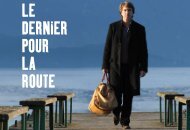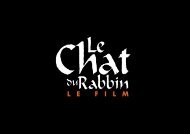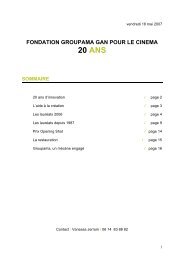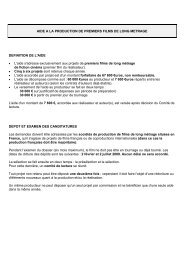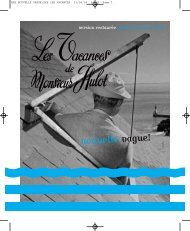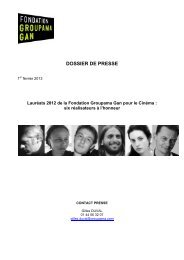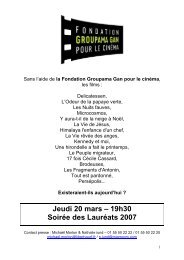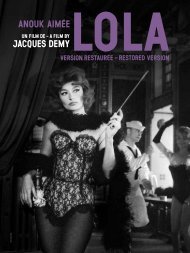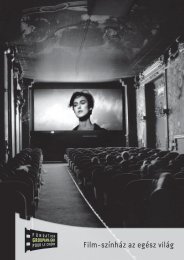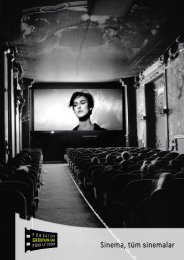duVoyage - Fondation Groupama Gan pour le Cinéma
duVoyage - Fondation Groupama Gan pour le Cinéma
duVoyage - Fondation Groupama Gan pour le Cinéma
Create successful ePaper yourself
Turn your PDF publications into a flip-book with our unique Google optimized e-Paper software.
Almost thirteen years after your first album, Moon Safari, you’ve put your name to the soundtrack<br />
of the colourised version of A Trip to the Moon. In what way are these two lunar expeditions connected?<br />
Nicolas Godin: Moon Safari corresponds, for us, to a period of innocence: we were starting out, we weren’t<br />
thinking in career terms. In a way, the images of A Trip to the Moon revived that lost innocence in us. They’re<br />
part of our unconscious: we don’t remember when we saw them for the first time, but we just know that they<br />
marked us – I especially remember a video by the Smashing Pumpkins which used extracts from the film,<br />
which bow<strong>le</strong>d me over, in the 1990s. Seeing these images again to set them to music took us way back to the<br />
world of childhood.<br />
Jean-Benoît Dunckel: Between Moon Safari and the original soundtrack of A Trip to the Moon, we <strong>le</strong>arned how to<br />
compose for images. Our music, in its beginnings, was very pop; it’s become more experimental over time.<br />
From Virgin Suicides to Quartier lointain, all your original soundtracks are about voyages in time<br />
and in space. This is the case again with A Trip to the Moon…<br />
Nicolas Godin: For each album, we take the listener by the hand and <strong>le</strong>ad him somewhere. That’s what music<br />
does. We have no other pretensions than that.<br />
Jean-Benoît Dunckel: Travel helps the mind to open, to change. Our music has the same ambition: to affect<br />
the body and the mind. Our ro<strong>le</strong> is similar to Madame Thuillier’s, who coloured Méliès’ film, or to ro<strong>le</strong> of rock<br />
musicians who played live in cinema theatres during a showing: it’s about prolonging the experience of film<br />
by stimulating the spectator’s brain. We don’t make rock music but psycho-acoustic music, ambience. That’s<br />
why our music works so well for voyages, and original soundtracks.<br />
You had <strong>le</strong>ss than twenty days to write and record the soundtrack. How did the recording sessions go?<br />
Nicolas Godin: The music gushed out very quickly, as if we’d been nurturing it for a life-time. Méliès’ universe<br />
belongs to the world’s col<strong>le</strong>ctive memory: the image of the moon with the rocket in its eye is anchored in each<br />
one of us. This film has come through decades with its evocative power intact.<br />
Jean-Benoît Dunckel: Méliès laid the base for several generations of film-makers, set decorators, creators of<br />
special effects – in the same way as the Beat<strong>le</strong>s defined the pop format in the 1960s. Had the definitions of<br />
Méliès or of the Beat<strong>le</strong>s been different, cinema or music would have been radically different.<br />
Your soundtrack is striking for its great synchronicity with the images of Méliès: each sound gives<br />
rhythm, stress, or punctuation to the action of the film. Drum and percussion play a dominant ro<strong>le</strong>…<br />
Nicolas Godin: We had great freedom compared to our previous experience of composing for images. For once,<br />
since the director is dead, there was nobody above us telling us what to do: we were ab<strong>le</strong> to work with each<br />
image, because we knew that everything we recorded would be preserved in the film. We played facing the<br />
screen, to synchronise the music better – which caused a bit of neck ache... In fact, this was our first time composing<br />
for a si<strong>le</strong>nt film: with no dialogue, the soundtrack becomes one of the main narrative threads. That<br />
freed us up, I think. The euphoric aspect of our score comes partly from that.<br />
180<br />
Jean-Benoît Dunckel: Méliès thought of his film as a series of scenes: it’s practically filmed theatre. With that<br />
static, vintage look, our music had to have dynamism, energy, modernity. Hence the importance we gave to<br />
rhythms: the drum is what allows you to most easily date a piece of music, to anchor it in the contemporary<br />
world.<br />
From a technological point of view, the film brings together very primitive special effects, from<br />
the stage or from painting, and the very latest restoration techniques. Your writing juxtaposes, in<br />
the same way, the organic and the e<strong>le</strong>ctronic, acoustic instruments and analog and digital effects.<br />
Have you favoured one of these two approaches?<br />
Jean-Benoît Dunckel: In our music the acoustic and the e<strong>le</strong>ctronic have always lived together to try to surprise<br />
and move the listener: the acoustic brings unctuosity and sincerity, whi<strong>le</strong> the e<strong>le</strong>ctronic stimulates the imagination.<br />
Nicolas Godin: A Trip to the Moon is undoubtedly more organic than most of our past projects. We wanted it to<br />
sound «hand-made», knocked together, a bit like Méliès’ special effects. Everything is played live. We used<br />
the mellotron for the sound effects, an ancestor of the synthesiser which you could find in all the English theatres:<br />
like Méliès’ film, our soundtrack is nourished by living art. We also did a lot of work on wind. Afterwards,<br />
it’s true that we like to play around with voices: we have no respect for them, we don’t have a sound<br />
hierarchy. Here, it seemed interesting to us to make the humans talk with animal sounds (hens, e<strong>le</strong>phants,<br />
etc), the opposite of Disney productions, where animals talk like humans. This is particularly the case in the<br />
astronomer sequence, where everyone is clucking as if in a hen-house: original ideas – to go to the moon – are<br />
fought against by the crowd of right-minded peop<strong>le</strong>.<br />
Your music is an admirab<strong>le</strong> mix of differing moods, alternating between light and more melancholy<br />
sequences.<br />
Jean-Benoît Dunckel: We used classic film music techniques, like modulating harmonies. For examp<strong>le</strong>, when<br />
the moon changes, the harmony changes. We really adapted ourselves to each scene of the film.<br />
Nicolas Godin: For the very bur<strong>le</strong>sque jumping scene on the moon, we imagined some fun music, a bit surf<br />
and psychedaelic. But we also bore in mind that discovering a new territory often corresponds to the end of<br />
a civilisation: that’s what happened with Christopher Colombus and it is I think, in places, what the film of<br />
Méliès evokes.<br />
Jean-Benoît Dunckel: Managing to balance the emotions is something that French musical composers, such<br />
as Michel Colombier or Georges De<strong>le</strong>rue, more easily succeed in doing than the Americans.<br />
181



